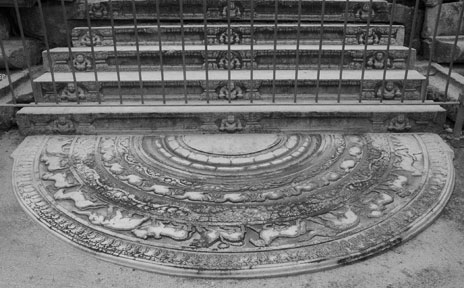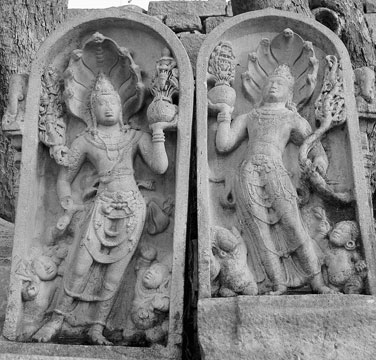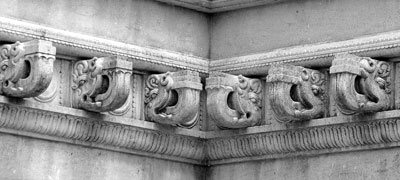|
National Archaeology Day fell on July 7:
Protecting archaeological heritage for the future
by Amal HEWAVISSENTI
 |
|
The moonstone |
One of the attractive aspects of archaeology is the sure element of
surprise. We are naturally governed by a sharply defined sense of pride
of having an archaeological legacy that goes back to the farthest point
of history of the island.
Sri Lanka has a baffling array of archaeological monuments and
artefacts that can readily compete with the priceless monuments
throughout the world.
Our irrigation technology that has evolved through centuries and the
masterly art that evoke deep taste and aesthetic feelings make the whole
world marvel at the top level Sri Lanka had reached in the past.
It is the duty of the younger generation to safeguard this national
heritage and transfer it with the same vitality to the future world.
Historic example
The ancient kings had a clear, well-organised mechanism to safeguard
the cultural heritage. In the third century BC, Sri Lanka’s national
heritage was nourished by the cultural legacy with the advent of
Buddhism.
Sri Lankan kings launched massive developmental programs to upgrade
the national heritage and gave full patronage to the building of more
monuments that show themselves in the form of ruins today.
Ancient Sri Lankan kings themselves have set a good example of
preserving archaeological wonders for future generations.
The inevitable relationship between Buddhism and the State gave
limitless protection for the priceless archaeological remains. And this,
on the other hand, was made possible by the Sri Lankan social thought
unconditionally nourished by Buddhist ethos.
Our kings, for the most part, were careful to lavish state patronage
for renovation of archaeological monuments erected by earlier rulers and
were running into dilapidation with the passage of time.
 |
|
Guard stone |
History records multiple incidents that spell out the rulers’
commitment to restore the buildings, statues or paintings to its
pristine grandeur. For instance, the Mahavamsa explicitly says how
‘Lowamaha Paya’ was restored and sometimes, modified by successive
kings.
According to the historical chronicles, the kings most often saw to
the maintenance of such heritage sites providing funds collected in the
form of tax levied on people.
Moreover, historical evidence shows that King Parakramabahu the Great
had appointed a special Minister to supervise the restoration of
heritage buildings and monuments that were running into a State of
disrepair and ruin.
Even King Nissankamalla had renovated a number of monuments and
appointed a team of officials to superintend the restoration work.
The record on Nissankamalla’s restoration of monuments such as
Mirisaweti makes it clear that he willingly continued the national
mission carried out by King Parakramabahu the Great during his reign.
What are archaeological remains?
The words ‘archaeological remains’ simply refer to the Buddhist,
Christian, Hindu or Islamic statues and monuments, pottery, paintings,
chaithyas and architectural marvels that belong to the time period
before 1815.
Here, pottery fragments and inscriptions are not an exception. Even
the Dutch fort of Galle, that is over hundred years old, falls into this
category. The archaeological monuments and artefacts are the physical
remains of unrivalled masterpieces and lifestyle of ancient people that
help to re-establish history.
There is, moreover, an accepted rule that legally defines a movable
or immovable property, that is more than hundred years old, as an
archaeological monument. Why should these be protected? Research based
on archaeological remains have uncovered the behavioural patterns moral
principles, economy and politics of the ancient world. The present
generation must pass this valuable knowledge on to the future
generation.
Though the Dutch were invaders to Sri Lanka their coastal fortresses
are now being protected as priceless archaeological evidence of their
invasion. Thus the monuments and historic places belonging to different
religious communities are being preserved as national heritage
irrespective of any distinctions.
Need for a national day
Harry Charles Perviyes Bell, an eminent Englishman launched the first
project of archaeological explorations with 28 men in Anuradhapura in
1890. This project which was popularly known as “Bell Party” later came
to be called `Archaeological survey of Ceylon’ (Archaeological
Department) within the British Government in Sri Lanka. We identify him
as the first Commissioner (Director General) of Archaeology.
However, Prof. Senarath Paranavitane was the first Sri Lankan to
become the Commissioner of Archaeology. In 1890 on international
conference of archaeologists from about twenty countries was held in
Colombo to mark the Centenary of the Department of Archaeology and July
7 was named as the National Archaeology Day.
Thus the Department of Archaeology that was established in 1890 is
the authority that accounts for the protection and preservation of
valuable monuments so far uncovered.
 |
|
Stone images |
In 1990, the Archaeological Department laid a sound foundation
towards protecting heritage sites for future generations by registering
some 11,185 heritage sites scattered in the country. Judging by the
historical records of the work done by Sri Lankan kings through
centuries, it is safer to conclude that more than 200,000 heritage sites
may have been scattered throughout the country.
Current challenges
The policymakers have a great responsibility to focus more on
domestic tourism specially cultural tours with a broader view points.
They should also take steps to direct domestic tourists to local
cultural attractions.
It is important to launch a wide propaganda on archaeological finds
from excavations and take them to the common people creating an
atmosphere in which they realise the value of artefacts uncovered.
Modern technology can widely be used to give publicity to the
artefacts and their practical value. It is not wide of the mark is we
say that our national heritage sites are lamentably in need of more
improved facilities for tourists such as accommodation, potable water
and toilet facilities.
It is totally opportune that new awareness programs on national
heritage sites registered so far should be mapped out. Thereby we can
create a powerful tourist attraction to those heritage sites.
We are better equipped to make successful arrangements to attract the
people and schoolchildren to the national museum and other provincial
museums. Experts on archaeology suggest that the authorities can focus
on building a group of mini-museums in which excavated buried remains
can be displayed to the public.
This is an effective way of promoting an unmistakable trend of museum
goers and increasing the people’s awareness of the historical value of
the particular heritage site.
For this, special program should be launched to make people aware of
the steps to be taken to curb the activities of treasure hunters and
those who sabotage archaeological remains. There is, at the same time a
popular suggestion to combine higher education institutions with the
archaeological sites.
Universities, schools for example, that are in close proximity to
archaeological heritage sites can organise special cleaning campaigns
and other projects that help to maintain them.
Our responsibility
 |
|
Intricate designs |
Projects such as these will call a halt to archaeological sites
deteriorating and preserve them in their pristine glory. A country such
as Sri Lanka cannot spend a massive capital on restoring all the
heritage sites that are profusely scattered throughout the country.
The State can encourage the trend for more research in which young
and energetic archaeologists can puzzle out mysteries surrounding the
particular heritage site and offer thought-provoking explanations to the
visitors.
That will definitely transfer the fresh knowledge to the future
generation. The modern techniques of reconstruction and rehabilitation
should be omitted because people like to see the heritage sites or
monuments in future precisely as they existed in the past.
Therefore, the most practical and appropriate way is preservation. On
the National Day of Archaeology, let’s be determined to preserve our
heritage that has its own historical and aesthetic value.
|

